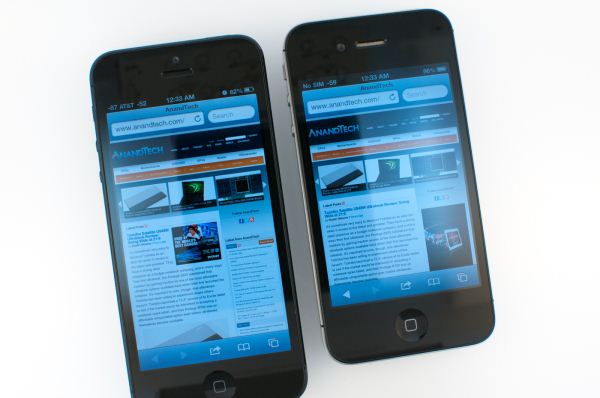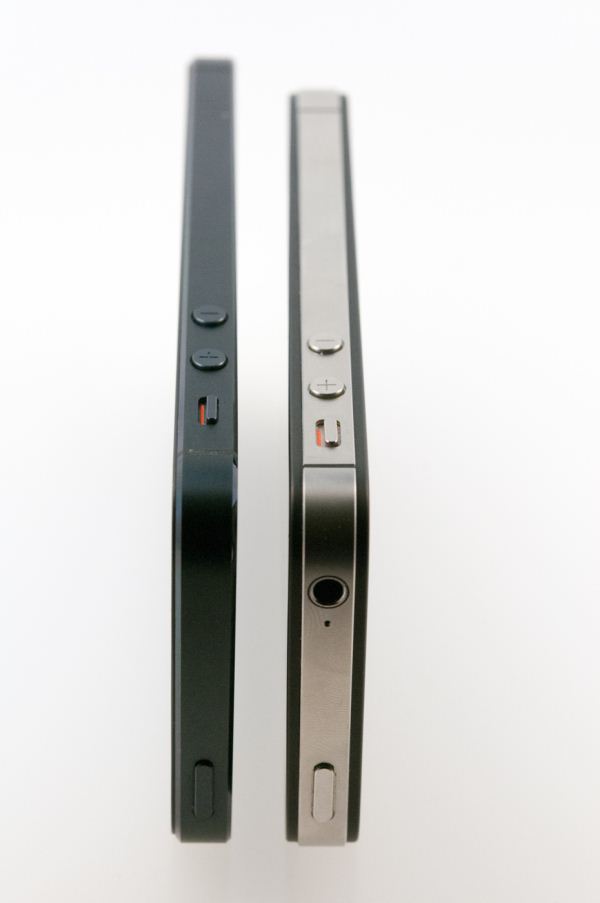The iPhone 5 Review
by Anand Lal Shimpi, Brian Klug & Vivek Gowri on October 16, 2012 11:33 AM EST- Posted in
- Smartphones
- Apple
- Mobile
- iPhone 5
The last significant redesign of the iPhone platform came in 2010 with the iPhone 4. It was an update that literally touched all aspects of the device, from SoC to display to baseband and of course, chassis. Last month’s launch of the iPhone 5 is no different in magnitude. The sixth generation iPhone makes some of the biggest changes to the platform since its introduction in 2007.
Visually the device begins by evolving the design language of the iPhone 4/4S chassis. From the launch of the iPhone 4 it was quite obvious that Apple had picked a design it was quite proud of. Thus it’s not too surprising that, from a distance, the iPhone 5 resembles the previous two iPhone models. We’ll get into material differences shortly, but what make the iPhone 5 design such a radical departure is its larger display.
All previous iPhones have maintained the same 3.5-inch, 3:2 aspect ratio display. With the rest of the world quickly moving to much larger displays, and with 16:9 the clear aspect ratio of choice, when faced with the decision of modernizing the iPhone platform the choice was obvious.
The iPhone 5 embraces a taller, 4-inch, 16:9 1136 x 640 display opting to lengthen the device instead of increasing its area in both dimensions. The result is a device that is distinctly an iPhone, albeit a modern one. The taller display doesn’t do much to make desktop web pages any easier to read as a result of the width staying the same. Those longing for an HTC One X or Galaxy S 3 sized device running iOS are out of luck. Reading emails and typing are both improved though as there’s now more room for lists and the keyboard no longer occupies as much of the display. The taller device can be more awkward to use if you have smaller hands, but the added screen real estate is honestly worth it. Once you get used to the iPhone 5’s display, going back to the older models is tough.
The taller chassis went on a diet as well. The iPhone 5 is now considerably thinner and lighter than its predecessor, which is yet another factor that contributes to it feeling more modern.
Internally the device changes are just as significant, if not more, than those on the outside. The iPhone 5 includes LTE support, which in areas where LTE networks are deployed can be enough reason alone to warrant an upgrade.
The iPhone 5 also includes a brand new SoC from Apple: the A6. For the first time since the introduction of the iPad, Apple has introduced a major branded SoC on an iPhone first. The iPhone 4 used the A4 after it debuted on the iPad, and the 4S picked up the A5 months after the iPad 2 launched with it. The A6 however arrives first on the iPhone 5, and with it comes two of Apple’s first, custom designed CPU cores. We’ve always known Apple as a vertically integrated device and software vendor, but getting into CPU design takes that to a new level.
| Physical Comparison | ||||
| Apple iPhone 4S | Samsung Galaxy S 3 (USA) | HTC One S | Apple iPhone 5 | |
| Height | 115.2 mm (4.5") | 136.6 mm (5.38" ) | 130.9 mm (5.15" ) | 123.8 mm (4.87") |
| Width | 58.6 mm (2.31") | 70.6 mm (2.78") | 65 mm (2.56") | 58.6 mm (2.31") |
| Depth | 9.3 mm ( 0.37") | 8.6 mm (0.34") | 7.8 mm (0.31") | 7.6 mm (0.30") |
| Weight | 140 g (4.9 oz) | 133g (4.7 oz) | 119.5g (4.21 oz) | 112 g (3.95 oz) |
| CPU | Apple A5 @ ~800MHz Dual Core Cortex A9 | 1.5 GHz MSM8960 Dual Core Krait | 1.5 GHz MSM8260A Dual Core Krait | 1.3 GHz Apple A6 (Dual Core Apple Swift) |
| GPU | PowerVR SGX 543MP2 | Adreno 225 | Adreno 225 | PowerVR SGX 543MP3 |
| RAM | 512MB LPDDR2-800 | 2 GB LPDDR2 | 1 GB LPDDR2 | 1 GB LPDDR2 |
| NAND | 16GB, 32GB or 64GB integrated | 16/32 GB NAND with up to 64 GB microSDXC | 16 GB NAND | 16, 32, or 64 GB integrated |
| Camera | 8 MP with LED Flash + Front Facing Camera | 8 MP with LED Flash + 1.9 MP front facing | 8 MP with LED Flash + VGA front facing | 8 MP with LED Flash + 1.2MP front facing |
| Screen | 3.5" 960 x 640 LED backlit LCD | 4.8" 1280x720 HD SAMOLED | 4.3" 960x540 Super AMOLED | 4" 1136 x 640 LED backlit LCD |
| Battery | Internal 5.3 Whr | Removable 7.98 Whr | Removable 6.1 Whr | Internal 5.45 Whr |
There’s a lot to talk about when it comes to the new iPhone. Whether it is understanding the architecture of the A6 SoC or investigating the improved low light performance of the iPhone 5’s rear facing camera, we’ve got it here in what is easily our most in-depth iPhone review to date. Let’s get started.












276 Comments
View All Comments
A5 - Tuesday, October 16, 2012 - link
Double the browsing time while moving to LTE and roughly the same in everything else despite double the performance is pretty impressive.rarson - Thursday, October 18, 2012 - link
I'm pretty sure they mentioned about a million times that "this is the new paradigm blah blah blah, where if you use heavy processing power more often, the battery life will diminish faster" (I'm paraphrasing here). I'm fine with that. The iPhone 5 shows some pretty impressive battery life in light workloads and doesn't actually do all that bad in heavy workloads despite how much number crunching it's doing, even though it might actually tank the battery life down to less-than-4S levels.It's a tradeoff: you get more power or longer battery life, depending on how you use it. The article paints this as a bad thing, but I disagree; it's obviously making much more efficient use of the hardware. Because of that, I definitely think the battery life overall is better, even though sometimes it might be worse. And you're still getting a lot more number crunching for the watts used.
Center - Tuesday, October 16, 2012 - link
In the intro, the screen specs on the iphone 5 is listed as 1136x960.. should be 1136x640.But great article as always, Anandtech!
Krysto - Tuesday, October 16, 2012 - link
I hope we'll see the same kind of thorough review of Samsung's Exynos 5 Dual chip, Anand.ltcommanderdata - Tuesday, October 16, 2012 - link
Isn't TI supposed to become the first shipping Cortex A15 SoC? I expect Anandtech to thoroughly review the first Cortex A15 SoC. There shouldn't be a need to go into the same detail (on the CPU side) for every subsequent one unless preliminary tests show something significantly different.Kidster3001 - Monday, October 22, 2012 - link
Samsung and Qualcomm do not ship generic ARM chips. They purchase licenses to use the ARM instruction set, not the chip design. Their chips are highly customized and perform differently.Using your logic to just review the first A15 class chip and consider the rest to be comparable is similar to just reviewing the first new car to be released every year and assume the rest will be comparable.
btw, TI is getting out of the business. I doubt they will ship first, or ever.
A5 - Tuesday, October 16, 2012 - link
Considering the fact that Krait got several articles here, I'd imagine that whatever the first shipping A15 chip is will get significant coverage.Wurzelsepp - Tuesday, October 16, 2012 - link
Great review, you really have to give Apple credit for building an amazing SoC.It's interesting to see how well the Adreno competes with SGX-543MP3, the new Nexus 4 with this GPU is going to be amazing.
Krysto - Tuesday, October 16, 2012 - link
One thing both the iPhone and the Intel Atom processors will keep lacking for a year from now, will be OpenGL ES 3.0 support. Apple might bring it to the new iPad 4 this spring, but the iPhone won't have it until the next iPhone, in the fall of 2013, obviously. Same with Intel, they won't be supporting it at least until end of 2013.In the meantime both Adreno 320 and Mali T604 are supporting it, and will come out this fall.
darwinosx - Tuesday, October 16, 2012 - link
A year from now and something 'coming out this fall". Right.